Lisa and I booked a 21-day tour with Sickelbill Safaris called Queensland Top to Bottom. To keep the blog post from being too long (that would be a lot of days to cover in one blog posting), I will post at least three, possibly four parts covering the trip. Any long delays are due to lack of internet service.
12 September 2017
We started our Queensland Top to Bottom Tour today by catching a flight from Cairns (pronounced Cans) to Lockhart River, located on Cape York Peninsula. We arrived in a Dash 8 airplane to overcast skies and windy weather. At least the temperatures were cool.
We got into our vehicle and began driving towards the community of Portland Roads on the Portland Roads Road (yes, I know confusing). We stopped at several places en route to our lodging at Portland Roads looking for parrots, riflebirds, honeyeaters, shorebirds – to name a few. Most of our birding is occurring within the confines of the Iron Range National Park.
My favorite spot of the day had to be Chili Beach, where we stopped for shorebirds. I finally got to see my Grey-tailed Tattler. We also had four different kinds of plovers: Red-capped, Pacific Golden, Lesser Sand, and Greater Sand Plover.
While watching and photographing a pair of Red-capped Plovers the male came up behind the female and started kicking its foot out at her vent (see photos below). He did this for about a minute or so before he mounted her. I’ve seen Sandhill Cranes mating and if you blink you could miss their copulation. Not so with Red-capped Plovers. The male must have been on top of the female for at least 15 seconds. Then the oddest think occurred – the male and female fell backwards onto ground. Later I wish I had video taped the event. Truly amazing to watch.
On the way back to our lodge (Portland House), we spotted a Large-tailed Nightjar. The female bird didn’t flush even under the hot spot light as it had a chick on its far side – momma protecting her young. Then further along the road we had a Papuan Frogmouth near the road. The bird flew off before we could get good looks at it.
Oh and least I forget, another great moment was at lunch. While eating our delicious food, several Lovely Fairywrens came into the campground where we were parked. These are truly beautiful birds and my bird of the day. Both the male and female are stunning. Unfortunately, I didn’t get any photographs. These birds don’t stand still for long – definitely not long enough for this photographer to capture a decent photo. To see what this bird looks like go to: http://www.graemechapman.com.au/library/viewphotos.php?c=142

One of the roads we birded

Here is the group waiting, and waiting, and waiting for a Magnificent Riflebird to appear.

Here is the group checking a local stream (need to watch out for crocodiles) for birds. Saw a beautiful Shining Flycatcher.




The Portland Roads Road

This is a primitive campground in the Iron Range National Park

The sign warning of salt water crocodiles in the streams



This is our vehicle. You really do need a 4WD vehicle for this part of the country. We never did see a regular AWD vehicle.

This Australian Bush Turkey has a different colored wattled (purple) from the Bush Turkeys found in and around Cairns (yellow)

Only a face a mother could love

Termite nest in a tree

These are actually wasps. At first I thought the little brown things were ants.

Female Shining Flycatcher – beautiful


Male Shining Flycatcher



Cane Toad

Isn’t it cute?

Chili Beach – lots of great shorebirds here. But it was very windy.



Driving was allowed on the beach

Our group in search of shorebirds

Common Sandpiper

Red-capped Plover. The male is in the back and he came behind the female where he would kick up his foot towards her vent …

… shown here

Then he copulated with the female, which lasted almost 15 seconds

Then they both fell backwards

Bar-shouldered Pigeons

Portland House – our accommodations for four nights
13 September 2017
Today our quest was the Palm Cockatoo, the Fawn-breasted Bowerbird, the Magnificent Riflebird, Red-cheeked Parrot, and the Yellow-billed Kingfisher. We did get a few other species in addition to these, including the Northern Scrub Robin, a bird which can be difficult to spot in the dense understory.
The morning was spent searching for the above key species. We found a Palm Cockatoo in the same area as the Fawn-breasted Bowerbird. The bowerbird builds a “bower” to attract a female. The Fawn-breasted Bowerbird’s bower is made up of thin sticks and is adorned with fruit (see photo). We stood for about 15 minutes waiting for the Bowerbird to come into its bower. We could hear the species, but not see it. Finally, I happened to look at the bower (I think most people were looking at other birds in the area), and there was the bird. We watched the male put in sticks, and shape the nest. I hope the female appreciates the effort.
Today’s humidity is greater than yesterday. After lunch, but before we went out for our afternoon birding foray, I walked the road near our lodge. It was HOT, HOT, HOT outside, and very muggy. When the wind did blow it was a welcomed relief. Despite the heat there were a fair number of birds flying, singing, and foraging in the trees.
After lunch we went back out birding in search of the Magnificent Riflebird. This bird is a member of the bird of paradise family. We went to an area where our guide has seen the bird perch. We sat on the ground and waited for the bird to make its rounds and come to the perch. After about 15-20 minutes, the bird flew onto a horizontal branch about 30 feet away from us. What a truly magnificent bird. Its name fits the bird to a tee. Although he didn’t stay long we did get excellent looks and a few decent photographs of the bird (not always easy in the dark rain forest).
The Orange-footed Scrubfowl is a small bird that can build a big nest on the forest floor. We saw one nest today that stood over 5 feet tall, and at least 10 feet wide. The thing was huge for a bird about the size of soccer ball.
We then continued birding and eventually found, after much anguish (we could hear the birds but not see them as they blend in well with the foliage) the Red-cheeked Parrot. The lighting was poor so I was unable to get a photo of the bird. The bird we found was a female so not as colorful as the male. Still a great bird to see and one that is localized to this particular area.

Here we are entering the rain forest to search for the Yellow-billed Kingfisher

But not all of the park is rain forest – here is tropical savanna




We spent a lot of time birding along the Portland Roads Road

Typical camper for the area

A Palm Cockatoo – this guy was way out in the distance. A good sized bird.

Lots of Common Sandpiper

The magnificent “Magnificent Riflebird”. This bird is a member of the bird of paradise family. Does stunning displays, which we unfortunately did not get to see.

Ben (our guide) and Jan
14 September 2017
In the morning we birded around Portland House (our accommodations for the first four days of our bird tour) – specifically the Mangrove swamps. We actually walked into the Mangroves in a few places. Luckily no crocs were around. That could be bad news. The goal was to find the Mangrove Robin, but this bird remained elusive – no calls or anything. Another target bird for the morning was the Rose-crowned Fruit Dove. This bird is one of three beautiful fruit dove species. We could hear them calling, but didn’t have much luck finding them until almost the end. Turns out the fruit dove was in the same tree as a Red-cheeked Parrot. We found the parrot first – a male this time. He is much more colorful.
After birding the Portland House area, we drove back to Chili Beach. Yay!!! I love the beach and shorebirds. We did get a Pied Oystercatcher. There were two of them on the beach and when they finally came together we saw they had a chick that had been hiding in some vegetation. So cute. The target bird here was the Beach Stone Curlew. No luck, however. We did get to see a new tern – Little Tern. This tern was much smaller than the other terns we’ve observed so far. Today the tide was much further out than two days ago so we could get some good looks at the different tern species roosting on a series of rocks just off the beach.
It was another hot, muggy day.
In the afternoon, after a brief siesta, we went back out birding in search of the ever elusive Yellow-billed Kingfisher. Despite hearing several birds calling close by, they remained elusive. We have one more day to find them.
We ate a box dinner (I’ve been eating a lot of bread on this trip – too much, in fact) and spent an hour searching for nightjars and frogmouths. Kim in our group spotted the Marbled Frogmouth, which isn’t always spotted on these trips. The bird had called and most of us walked right under the bird looking for it in the trees to the side of the trail, rather than over the trail. Way to go Kim. She’s been good at spotting a lot of our species today.
On the way back to our lodging, we also got to see the Papuan Frogmouth – much better views this time. This frogmouth is much bigger than the Marbled, and more abundant. All frogmouths are great birds to see.
I do have to mention that the food at the café adjacent to the Portland House has been delicious. I think I will have gained a pound or two in the four short days here.

Rose-crowned Fruit Dove. The Fruit Doves are difficult to find and see in the high canopy, so we were fortunate to have this one in the relatively open.

We went back to Chili Beach and found this Pied Oystercatcher. I just love this beach and all the shorebirds there.

Golden-Orb Spider – a big spider

A Dingo


Wompoo Fruit Dove – beautiful, colorful bird
15 September 2017
Today our quest was the Yellow-billed Kingfisher. If we didn’t get the bird here we wouldn’t get it anywhere else on our trip. The pressure was on. We have been looking for this bird for the past two days, spending at least 2-3 hours in our search. The bird was heard a number of times, and in some instances seemed to be just above us. But no matter how hard we searched we could not find it.
En route to the rain forest (that is where the kingfisher would most likely be found – it is a forest kingfisher, not a riverine kingfisher), we spotted several Palm Cockatoos flying overhead. We quickly stopped the car, got out, and found one of the cockatoos in a nearby tree, sitting pretty as you please. We all started snapping off photos. The bird then flew to the other side of the road, in a tree that let us get even better views and photos (better lighting). What a magnificent, spectacular bird. In all, we had 5 Palm Cockatoos in the flock.
Then back into the vehicle to find the kingfisher. We tried several locations, finally ending up near the Rainforest campground. There we heard several birds, but didn’t see them. Finally we walked into the rain forest, in an area where we heard 4 kingfishers the first day we tried for the bird. Kim, one of our fellow tour participants, found the kingfisher in the tree. Problem was only three of the seven people found the bird before it flew off not to be spotted again. After several more tries to find the bird at this location (again hearing, but not seeing the bird), we left to check out other potential locations. After no luck, we continued onto the community of Lockhart River. This community of 700 people consists primarily of aboriginal people. Our guide was told by the mayor that we could not take photos. I guess some woman was taking photos of their emaciated dogs and he didn’t like it. I told the guide – Ben – that maybe they should feed the dogs. They did look pretty sad. Can’t say the same for the residents.
We visited the Community Farm Dam, Sewage Treatment Ponds, and the beach near the community searching for birds. The best bird found was the Red-backed Fairywren, especially the juvenile. What beautiful birds. I love the fairywrens.
Afterwards we headed back to the rain forest to conduct one last search for the Yellow-billed Kingfisher. We went back to our favorite spot near the Rainforest campground. This time we scored – all seeing the kingfisher thanks again to Kim.
We can now leave the Iron Range National Park having spotted all but one of the special localized species of this area – birds generally not found elsewhere (or at least not where our tour will take us). Tomorrow we head to Lakefield National Park, south of Lockhart River. I’ve really enjoyed this area, the Portland House, and Sheree and Greg our hosts. The meals were fabulous. One night they serve fresh lobster and prawns. And of course great French fries (aka “chips”).

Fruit of the Red Beech

Palm Cockatoo – got good views of the bird today

Looks like it is having a bad hair day

Maybe it doesn’t like us hanging around

We spend a lot of time waiting and searching for the birds



And walking the roads – good exercise though

These are green ants and they are making a nest out of leaves. They weave or connect the leaves together using larval silk.



Our guide trying to get us on the bird

Lots of pretty butterflies here too

And epiphytes abound

And termite mounds

Regular burning of the forest occurs to prevent the rain forest from encroaching on the savanna

The Lockhart River community dam – we came here to check out the birds


Love the purple water lilies

Whistling Kite

Pied Heron (immature)

Lockhart River sewage ponds – lots of great birds here

Australasian Grebe

And yes, we FINALLY, saw the Yellow-billed Kingfisher near the end of the day. This was our last chance to find this bird, which is a localized endemic.

Sunset at Portland House – tomorrow we leave here for points south
16 September 2017
Today we left the Portland House and the Iron Range National Park. We did make a quick stop at the Eclectus Parrot tree where there were two females guarding their nest (in a hole in the tree). Good thing too because two Sulphur-crested Cockatoos proceeded to fly to the tree and try to inspect the nest hole. We could see the cockatoos peeling the bark away near the hole. Not sure why they were doing that. One of the female Eclectus Parrots was outside of the tree and another was in the nest hole. Once in awhile the parrot in the nest hole would stick her head out. She was not happy to have the cockatoos trying to take over her nest.
We then proceeded towards Musgrave Station, stopping at a few places along the way to check out plants and birds. At Winlock River we got to see one of my more sought after birds – the Blue-faced Honeyeater (see photo). What a cool looking bird. And whenever you are near a water body you need to keep at least 20 feet back due to crocodiles. Luckily we haven’t seen any yet.
We stopped for lunch at Archer River Roadhouse. The place was busy (not a lot of places to stop and eat or camp along the Portland Development Road). The food was good, but not cheap. I think my lunch alone cost about $27.00 Australian dollars. Kind of like eating in bush Alaska.
Our next stop was at the community of Coen. I was surprised at how large a community it was (very small by most standards, but large for the area). Here we got our first glimpse of Galahs (see photos). This is another bird I was hoping to see in Australia.
We did make an emergency stop to save a Blue-tongued Skink (Lizard) from being run over by the crazy road traffic. I’m surprised at how much traffic there is in this undeveloped part of the country. Most of the roads we have traveled are gravel and people drive fast.
Before reaching our destination – Musgrave Roadhouse, we had car problems. The muffler pipe on our vehicle cracked. Not good news. We did make it to the roadhouse and are now waiting to hear what will be done to fix the problem.

Double-eyed Fig Parrot

The view from Portland Roads (where Portland House is located)

Female Eclectus Parrot


Sulphur-crested Cockatoos checking out the Eclectus Parrot nest hole – looking to take it over



Iron Range National Park boundaries

Pitcher Plant






A sundew plant – this plant is smaller than a dime

Another type of sundew


We saw this outline on the road. Our guide said he doesn’t recognize the animal – maybe someone’s dog


Steve standing in the water covering the road

One of the “few” sections of paved road on what is known as the Portland Development Road

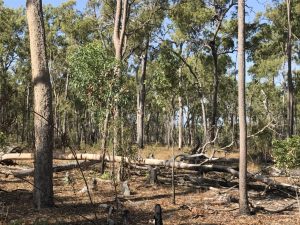

This gobular termite mound is about four feet tall


Torresian Crow

Blue-faced Honeyeater

Blue-tongued Skink – he was about 1.5 feet long, and chubby. Slow moving too. Jan was nice enough to poke him along. Probably saved him from becoming road kill.

Great Bowerbird

Galahs (a type of parrot)


Agile Wallaby – there were quite a few around the Musgrave Roadhouse

Diamond Dove



This cow was checking us out while we were looking for birds in the large parking lot at Musgrave Roadhouse
17 September 2017
After an early breakfast we headed out in search of the Golden-shouldered Parrot. This parrot is endangered and only about 1,000 remain in the wild. This is the place to be (near Musgrave Roadhouse) if you are going to see them.
We walked the field adjacent to the road and despite getting 20 new species we did not see the parrot. We will try again tomorrow for the bird. We also got to see some favorites, like the Red-backed Fairywren, which I was almost able to photograph. I should start counting the number of times I have my finger on the button to click off a photo and the bird flies off.
We drove back to the Musgrave Road house for a little birding around the grounds, lunch, and a 2 hour catnap or whatever. I did go out to check an area where a Latham’s Snipe had been spotted the night before. No luck. However, I did see a Brolga (type of crane) family – mom, dad, and a colt. Too far away to get a decent photo, and with the heat waves even looking at them was difficult.
After a couple hour siesta we were back into our loud Toyota Land Cruiser and off to find more birds. We drove to a road called Lilyvale and saw a rare Red Goshawk on a nest. The female was straddling the nest protecting at least one young. This is one beautiful raptor and my photo does not do the bird justice. Google the bird and you will probably find some beautiful photos of the bird.
After birding Lillyvale Road we head to the Lotusbird Lodge and the lagoon they have near their guest cabins. This lagoon was filled with hundreds of waterfowl and waders. I was mesmerized by all the different bird species. I think my two favorite ducks were the Hardhead (yeah, strange name) and the Pink-eared Duck (you can see a little bit of pink on their head). The Pink-eared Duck has the strangest bill of any duck I’ve ever seen. At first I thought it looked like a shoveler’s bill, which it does in some respects, but the bill turns down at the sides (See Photo). Most weird. I would definitely like to spend more time here.
We were supposed to visit Lakefield National Park but due to our vehicle’s mechanical problems we stayed closer to Musgrave Station.

Black-backed Butcherbird

Blue-winged Kookaburra
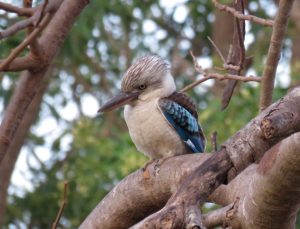


Lots of Eucalyptus Trees

This layering is actually caused by termites and is their nest.

Here we are looking for the Golden-shouldered Parrot, a seed-eater.

And this is their habitat

A Grass Tree

Magnetic Termite Mound – supposedly they are oriented north and south

White-throated Gerygone (pronounced ge-ryg-o-ne)

Female White-winged Triller

Weebird


The gravel portion of Portland Development Road



Double-barred Finch

Little Friarbird

White-winged Triller

Australian White Ibis


Large flock of Plumed Whistling Ducks

Red Goshawk

Lotus Lagoon – lots of Magpie Geese (foreground) and a variety of ducks, cormorants, shorebirds, and waders. I loved this place. So much to see.

Pink-eared Ducks

They have a really strange bill

Magpie Geese feeding

Black-backed Butcherbirds

Masked Lapwing

Little Black Cormorants

White-headed (or Black-winged) Stilt

Our accommodations at Musgrave Roadhouse
18 September 2017
Today was our final search for the Golden-shouldered Parrot. We went to check out a dam where the birds have been known to come to drink. They didn’t show, although other birds did come for their thirst and our enjoyment. However, I think the birds knew we were there as they seem reluctant to come to the water to drink. The cows though didn’t see to care about our presence.
After about an hour at the dam, we then went to several other areas and walked the woods in search of the birds, but we got skunked on this bird – a no show, although several thought they heard the bird.
Sometimes I wonder about our quest to see so many of the world’s birds. I think it is great there is such an interest in birds, but I also worry about the impact that we have on the birds – chasing through their habitat, playing their calls to attract them, getting too close to the birds. A growing dilemma for me.
We did see a few new birds today despite not seeing the parrot. On our way to Redmill House in Daintree, we saw about 50 or more cranes – mostly Sarus Cranes and fewer Brolga (another crane). We also see the Australian Bustard. Like Jack, I too like the big birds.
We drove over 300 kilometers (180+ miles) today. At Laura (a small community) we changed vehicles. We now have a van with more seating, but not as comfortable seating. Always a tradeoff. Nothing in life is perfect – well except the birds.
Since leaving Portland House we’ve been traveling on the Portland Development Road. This road is most gravel, with interspersed paved areas. I sometimes wonder why one area is paved and another is not. Before Lisa and I signed up for this tour we had talked about renting a 4wd vehicle and driving this road to visit Lakefield and Iron Range National Parks. Having now driven on the road I’m glad we decided to go with a tour and leave driving and logistics to someone else.
Where we have dead deer on the sides of the roads (at least in the lower 48), here I’ve seen dead wallabies on the road. So sad.
Also of note, there isn’t a lot of litter alongside the roads. This is always a positive.

Common Bronzewing …

… here at the watering hole

Pale-headed Rosellas

Australian Hobby

Sarus and/or Brolga Cranes in flight

Rainbow Lorikeet (properly named bird)


Australian Bustard


Brown Falcon

Apostlebird

This is a “bower” of a Great Bowerbird. The males “adorn” their bowers to attract females.

Lots of white plastic pieces

Tawny Frogmouth


Pale-headed Rosella getting a drink of water

Mt. Carbine Caravan Park – some of the campsites



We did get a different vehicle since the exhaust pipe in our original vehicle cracked

Here is another outline of the same animal. Someone’s idea of a joke, I guess. Our guide wasn’t sure of the origin.

Ah, what is traveling without some kind of road construction
Next stop – the Wet Tropics of the Cairns area. Until then …
























































































































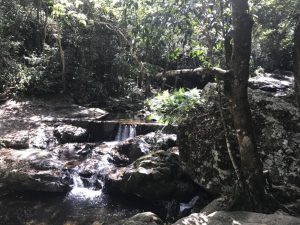

































































































































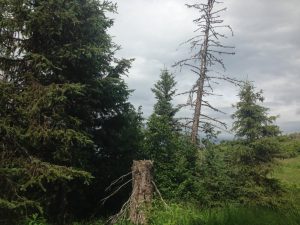










































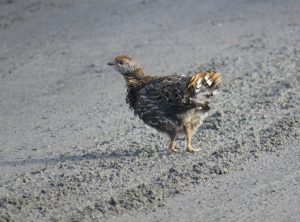

















































Recent Comments